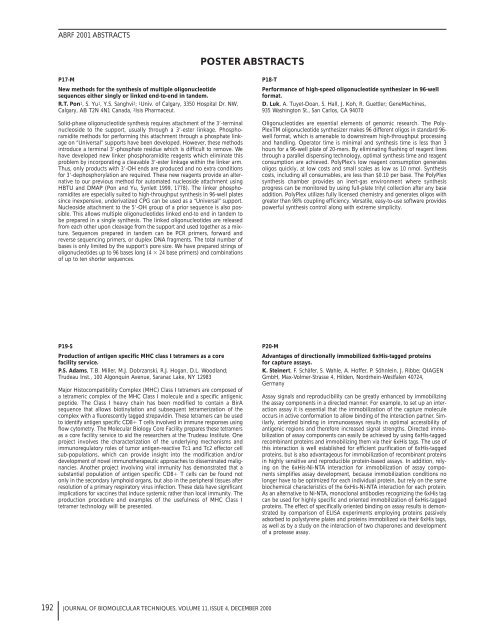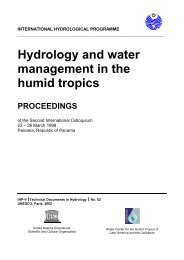FR AB - Science Reference
FR AB - Science Reference
FR AB - Science Reference
Create successful ePaper yourself
Turn your PDF publications into a flip-book with our unique Google optimized e-Paper software.
<strong>AB</strong>RF 2001 <strong>AB</strong>STRACTS<br />
P17-M<br />
New methods for the synthesis of multiple oligonucleotide<br />
sequences either singly or linked end-to-end in tandem.<br />
R.T. Pon1, S. Yu1, Y.S. Sanghvi2; 1Univ. of Calgary, 3350 Hospital Dr. NW,<br />
Calgary, <strong>AB</strong> T2N 4N1 Canada, 2Isis Pharmaceut.<br />
Solid-phase oligonucleotide synthesis requires attachment of the 3�-terminal<br />
nucleoside to the support, usually through a 3�-ester linkage. Phosphoramidite<br />
methods for performing this attachment through a phosphate linkage<br />
on “Universal” supports have been developed. However, these methods<br />
introduce a terminal 3�-phosphate residue which is difficult to remove. We<br />
have developed new linker phosphoramidite reagents which eliminate this<br />
problem by incorporating a cleavable 3�-ester linkage within the linker arm.<br />
Thus, only products with 3�-OH ends are produced and no extra conditions<br />
for 3�-dephosphorylation are required. These new reagents provide an alternative<br />
to our previous method for automated nucleoside attachment using<br />
HBTU and DMAP (Pon and Yu, Synlett 1999, 1778). The linker phosphoramidites<br />
are especially suited to high-throughput synthesis in 96-well plates<br />
since inexpensive, underivatized CPG can be used as a “Universal” support.<br />
Nucleoside attachment to the 5�-OH group of a prior sequence is also possible.<br />
This allows multiple oligonucleotides linked end-to end in tandem to<br />
be prepared in a single synthesis. The linked oligonucleotides are released<br />
from each other upon cleavage from the support and used together as a mixture.<br />
Sequences prepared in tandem can be PCR primers, forward and<br />
reverse sequencing primers, or duplex DNA fragments. The total number of<br />
bases is only limited by the support’s pore size. We have prepared strings of<br />
oligonucleotides up to 96 bases long (4 � 24 base primers) and combinations<br />
of up to ten shorter sequences.<br />
P19-S<br />
Production of antigen specific MHC class I tetramers as a core<br />
facility service.<br />
P.S. Adams, T.B. Miller, M.J. Dobrzanski, R.J. Hogan, D.L. Woodland;<br />
Trudeau Inst., 100 Algonquin Avenue, Saranac Lake, NY 12983<br />
Major Histocompatibility Complex (MHC) Class I tetramers are composed of<br />
a tetrameric complex of the MHC Class I molecule and a specific antigenic<br />
peptide. The Class I heavy chain has been modified to contain a BirA<br />
sequence that allows biotinylation and subsequent tetramerization of the<br />
complex with a fluorescently tagged strepavidin. These tetramers can be used<br />
to identify antigen specific CD8� T cells involved in immune responses using<br />
flow cytometry. The Molecular Biology Core Facility prepares these tetramers<br />
as a core facility service to aid the researchers at the Trudeau Institute. One<br />
project involves the characterization of the underlying mechanisms and<br />
immunoregulatory roles of tumor antigen-reactive Tc1 and Tc2 effector cell<br />
sub-populations, which can provide insight into the modification and/or<br />
development of novel immunotherapeutic approaches to disseminated malignancies.<br />
Another project involving viral immunity has demonstrated that a<br />
substantial population of antigen specific CD8� T cells can be found not<br />
only in the secondary lymphoid organs, but also in the peripheral tissues after<br />
resolution of a primary respiratory virus infection. These data have significant<br />
implications for vaccines that induce systemic rather than local immunity. The<br />
production procedure and examples of the usefulness of MHC Class I<br />
tetramer technology will be presented.<br />
POSTER <strong>AB</strong>STRACTS<br />
192 JOURNAL OF BIOMOLECULAR TECHNIQUES, VOLUME 11, ISSUE 4, DECEMBER 2000<br />
P18-T<br />
Performance of high-speed oligonucleotide synthesizer in 96-well<br />
format.<br />
D. Luk, A. Tuyet-Doan, S. Hall, J. Koh, R. Guettler; GeneMachines,<br />
935 Washington St., San Carlos, CA 94070<br />
Oligonucleotides are essential elements of genomic research. The Poly-<br />
PlexTM oligonucleotide synthesizer makes 96 different oligos in standard 96well<br />
format, which is amenable to downstream high-throughput processing<br />
and handling. Operator time is minimal and synthesis time is less than 3<br />
hours for a 96-well plate of 20-mers. By eliminating flushing of reagent lines<br />
through a parallel dispensing technology, optimal synthesis time and reagent<br />
consumption are achieved. PolyPlex’s low reagent consumption generates<br />
oligos quickly, at low costs and small scales as low as 10 nmol. Synthesis<br />
costs, including all consumables, are less than $0.10 per base. The PolyPlex<br />
synthesis chamber provides an inert-gas environment where synthesis<br />
progress can be monitored by using full-plate trityl collection after any base<br />
addition. PolyPlex utilizes fully licensed chemistry and generates oligos with<br />
greater than 98% coupling efficiency. Versatile, easy-to-use software provides<br />
powerful synthesis control along with extreme simplicity.<br />
P20-M<br />
Advantages of directionally immobilized 6xHis-tagged proteins<br />
for capture assays.<br />
K. Steinert, F. Schäfer, S. Wahle, A. Hoffer, P. Söhnlein, J. Ribbe; QIAGEN<br />
GmbH, Max-Volmer-Strasse 4, Hilden, Nordrhein-Westfalen 40724,<br />
Germany<br />
Assay signals and reproducibility can be greatly enhanced by immobilizing<br />
the assay components in a directed manner. For example, to set up an interaction<br />
assay it is essential that the immobilization of the capture molecule<br />
occurs in active conformation to allow binding of the interaction partner. Similarly,<br />
oriented binding in immunoassays results in optimal accessibility of<br />
antigenic regions and therefore increased signal strengths. Directed immobilization<br />
of assay components can easily be achieved by using 6xHis-tagged<br />
recombinant proteins and immobilizing them via their 6xHis tags. The use of<br />
this interaction is well established for efficient purification of 6xHis-tagged<br />
proteins, but is also advantageous for immobilization of recombinant proteins<br />
in highly sensitive and reproducible protein-based assays. In addition, relying<br />
on the 6xHis-Ni-NTA interaction for immobilization of assay components<br />
simplifies assay development, because immobilization conditions no<br />
longer have to be optimized for each individual protein, but rely on the same<br />
biochemical characteristics of the 6xHis-Ni-NTA interaction for each protein.<br />
As an alternative to Ni-NTA, monoclonal antibodies recognizing the 6xHis tag<br />
can be used for highly specific and oriented immobilization of 6xHis-tagged<br />
proteins. The effect of specifically oriented binding on assay results is demonstrated<br />
by comparison of ELISA experiments employing proteins passively<br />
adsorbed to polystyrene plates and proteins immobilized via their 6xHis tags,<br />
as well as by a study on the interaction of two chaperones and development<br />
of a protease assay.















